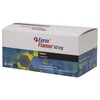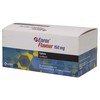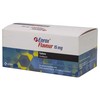Enrox
Enrox Flavoured Tablets are for the treatment of bacterial infections of the alimentary, respiratory and urogenital tracts, skin, secondary wound infections and otitis externa where clinical experience, supported where possible by sensitivity testing of the causal organism, indicates enrofloxacin as the drug of choice.
Enrox Tablets are round, slightly convex tablets that are cream to light brown in colour.
Enrox 50mg Flavoured Tablets for Dogs
£1.45Enrox 50mg Flavoured Tablets are indicated for use in cats and dogs in the treatment of bacterial infections of the alimentary, respiratory and urogenital tracts. Enrox Tablets can also be...[More info]
Enrox 150mg Flavoured Tablets for Dogs
£3.52Enrox 150mg Flavoured Tablets are indicated for use in cats and dogs in the treatment of bacterial infections of the alimentary, respiratory and urogenital tracts. Enrox Tablets can also be...[More info]
Enrox 15mg Flavoured Tablets for Dogs and Cats
£0.72Enrox 15mg Flavoured Tablets are indicated for use in cats and dogs in the treatment of bacterial infections of the alimentary, respiratory and urogenital tracts. Enrox Tablets can also be...[More info]
Dosage and administration
FOR ORAL ADMINISTRATION.
DO NOT EXCEED RECOMMENDED DOSE.
5mg enrofloxacin per kg bodyweight per day. Given orally once daily or as a divided dose twice daily for 5 to 10 days with or without food.
Daily dose achieved as follows:
Cats and small dogs = 1 Enrox Flavour Tablet 15mg per 3kg bodyweight
Medium dogs = 1 Enrox Flavour Tablet 50mg per 10kg bodyweight
Large dogs = 1 Enrox Flavour Tablet 150mg per 30kg bodyweight
The duration of treatment in dogs may be extended depending on the clinical response and the judgement of the responsible veterinary surgeon.
To ensure a correct dosage body weight should be determined as accurately as possible to avoid underdosing.
Use during pregnancy and lactation
As enrofloxacin passes into maternal milk, use only according to the benefit/risk assessment by the responsible veterinarian.
Contra-indications, warnings, etc
Do not use in dogs less than 1 year of age or in exceptionally large breeds of dog with a longer growth period less than 18 months of age, as articular cartilage may be affected during the period of rapid growth.
Do not use in cats less than 8 weeks of age.
Do not use in case of hypersensitivity to the active substance or to any of the excipients.
Do not use in dogs having seizure disorders, since enrofloxacin may cause CNS stimulation.
Do not use for prophylaxis.
In accidental overdose, vomiting, diarrhoea and CNS/behavioural changes may occur.
There is no antidote and treatment should be symptomatic. If necessary, administration of aluminium- or magnesium-containing antacids or activated carbon can be used to reduce absorption of enrofloxacin.
In target animal species, cats have been shown to suffer ocular damage after receiving doses of more than 15 mg/kg once daily for 21 consecutive days. Doses of 30 mg/kg given once daily for 21 consecutive days have been shown to cause irreversible ocular damage. At 50 mg/kg given once daily for 21 consecutive days, blindness can occur.
Interactions
Do not combine with tetracyclines, phenicols or macrolides because of potential antagonistic effects.
Concurrent administration of fluoroquinolones may increase the action of oral anticoagulants.
Do not combine with theophylline as this could lead to a prolonged elimination of this substance.
Concurrent administration of magnesium or aluminum containing substances may be followed by retarded absorption of enrofloxacin.
Special precautions for use in animals
Fluoroquinolones should be reserved for the treatment of clinical conditions which have responded poorly, or are expected to respond poorly to other classes of antimicrobials.
Whenever possible, use of fluoroquinolones should be based on susceptibility testing. Use of the product deviating from the instructions given in the SPC may increase the prevalence of bacteria resistant to the fluoroquinolones and may decrease the effectiveness of treatment with other quinolones due to the potential for cross-resistance.
Official and local antimicrobial policies should be taken into account when the product is used.
Do not use in case of resistance to quinolones, as there exists almost complete cross resistance to other quinolones and complete cross resistance to other fluoroquinolones.
15mg
Do not exceed the recommended dosage.
Retinotoxic effects including blindness can occur in cat when the recommended dose is exceeded.
Use the product with caution in dogs with severe renal or hepatic impairment.
Special precautions to be taken by the person administering the veterinary medicinal product to animals
Wash hands after use. In case of contact with the eyes, wash with plenty of clean water. In case of accidental ingestion, seek medical advice immediately and show the package leaflet or the label to the physician. People with known hypersensitivity to (fluoro)quinolones should avoid contact with the product.
Environmental Safety
Any unused veterinary medicinal product or waste materials derived from such veterinary medicinal products should be disposed on in accordance to local requirements.


